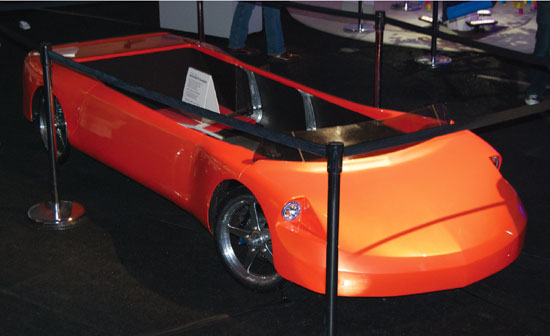Move Over, Flintstones
By Anna Lena Phillips
This human-electric hybrid car is powered by rowing, not running
This human-electric hybrid car is powered by rowing, not running

DOI: 10.1511/2009.76.24
The history of hybrid vehicles includes as many grand ideas and false starts as practical successes. This is especially true for human-powered hybrids—the steam bicycle, for instance, is not much in use these days. But environmental concerns are shifting the balance. The latest candidate for hybrid stardom? The human-electric car.
The concept is getting a big push from father-and-son team Charles and Chuck Greenwood. Their Seattle, Washington, company, HumanCar, is slated to release its latest model, the Imagine PS, on Earth Day 2009. They have already received more than 100 preorders for this low-speed car, which will sell for an estimated $15,500.

Photograph courtesy of HumanCar.
Charles Greenwood, a mechanical engineer who says he has always loved building hotrods, worked for 30 years to develop a four-wheeled car powered by humans alone. The Imagine PS is the next step: a human-electric hybrid that can run on human power, a battery or a combination of the two—and can serve as a modest home power station.
To run on human power alone takes four people, two facing forward and two facing back. Each “passenger” uses a rowing motion to pull and push their own T-shaped bar. “When the person behind you is doing their pull, you’re simultaneously doing a push, so you’re directly cooperating,” Greenwood says. The action moves a system of connecting rods that power a crankshaft. “It’s exactly analogous to how a regular steam or combustion engine pushes the pistons.” Drivers facing forward use one axis to power the car and steer by moving their T-bars along the opposite axis. Turn on battery power, and you can work as much or as little as you like, with one to four passengers. The car reaches 30 miles per hour comfortably, says Greenwood, and it can make 60 mph on a good hill.
But buyers shouldn’t expect to go 60 mph yet. The current model includes a regulator that caps the speed at around 35 mph, making it legal where low-speed vehicles are allowed in most of the United States. But the Imagine already includes features for higher-speed travel. And a 70-mph prototype is on the way. Greenwood expects most buyers will “option up” later, swapping out motors and battery packs for more power, “kind of like upgrading your computer.”
The Imagine is equipped with front and side crush zones containing gas-compression airbags, so drivers will have some protection in case of a crash. It has a doorless, step-through body, which is stronger structurally. A roof with six-point roll cage can be added on. And the four-wheel design adds stability.
Greenwood claims his car can blend in easily with urban traffic. But wouldn’t it feel scary to drive a car that weighs a trim 550 pounds among two-ton traditional cars? “That’s the first issue,” says Greenwood, “do you feel vulnerable or not? Well, frankly, you feel quite victorious! You’re out there demonstrating in traffic that, gee, we don’t have to stop at the gas station or, you know, invade another country or any of this stuff.”
With its wheels disengaged, the car can be used like a workout machine to generate power. Greenwood likes to think of human power output in “watt-minutes” rather than kilowatt-hours—it will charge smaller devices such as cell phones and iPods.
Whether or not the Imagine PS catches on, Chris Hardwicke, an urbanist with Toronto architecture firm Sweeny Sterling Finlayson & Co., advises planning for success. “I always think there’s a test that you need to try with these transportation ideas,” he says. “Sure, it’s a neat idea for one person to have it, but what if it gets really successful? Then what happens with congestion? How do you distribute, how do you share the road?”
Greenwood dreams of a transit plan including standardized powered tracks for individual cars. Carmakers could build electric and hybrid cars to run on the tracks—and go “off-line” on regular roads to complete their journeys. This may sound a little far-fetched, but Hardwicke notes that 150 years ago, how transit would work was an open question. “What happened to those pre-oil ideas?” he asks. “Soon they will be big business.” The Greenwoods are hoping he’s right.—Anna Lena Phillips
Click "American Scientist" to access home page
American Scientist Comments and Discussion
To discuss our articles or comment on them, please share them and tag American Scientist on social media platforms. Here are links to our profiles on Twitter, Facebook, and LinkedIn.
If we re-share your post, we will moderate comments/discussion following our comments policy.